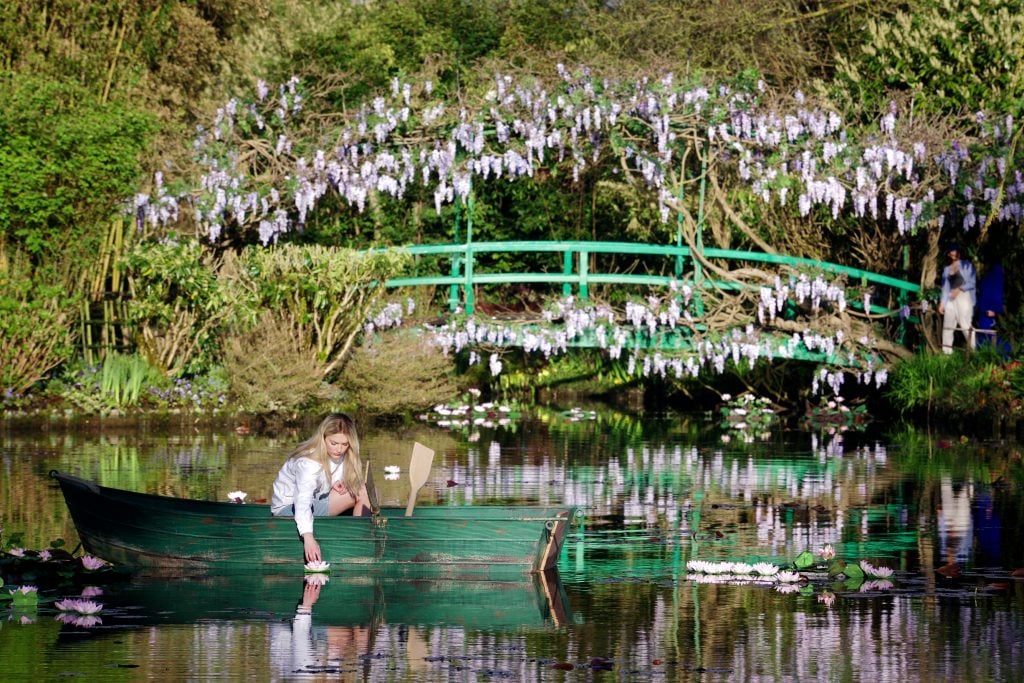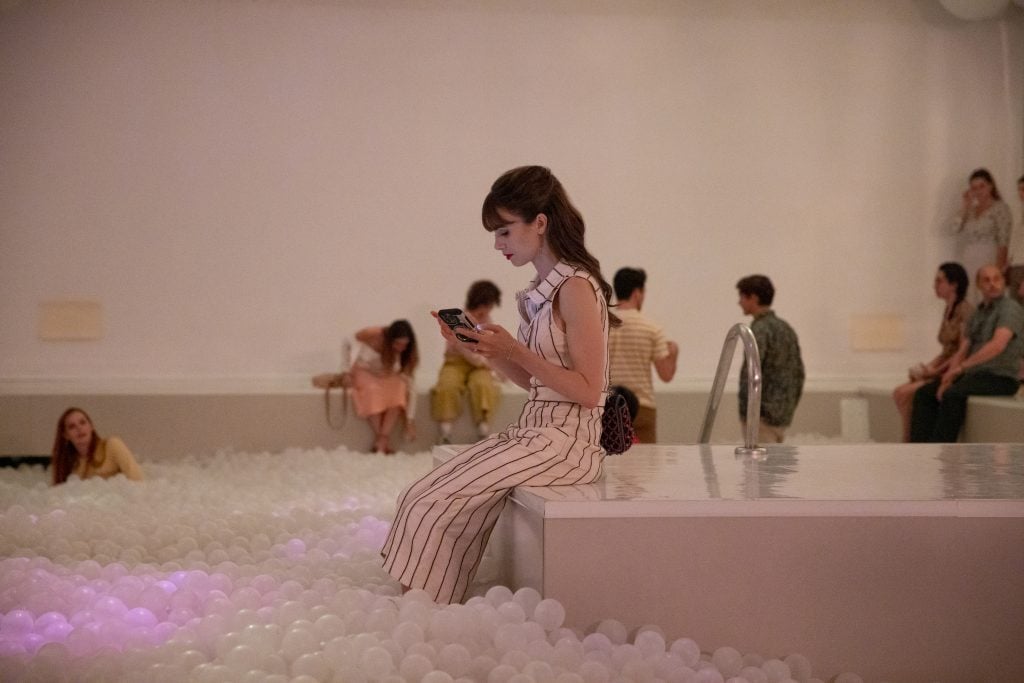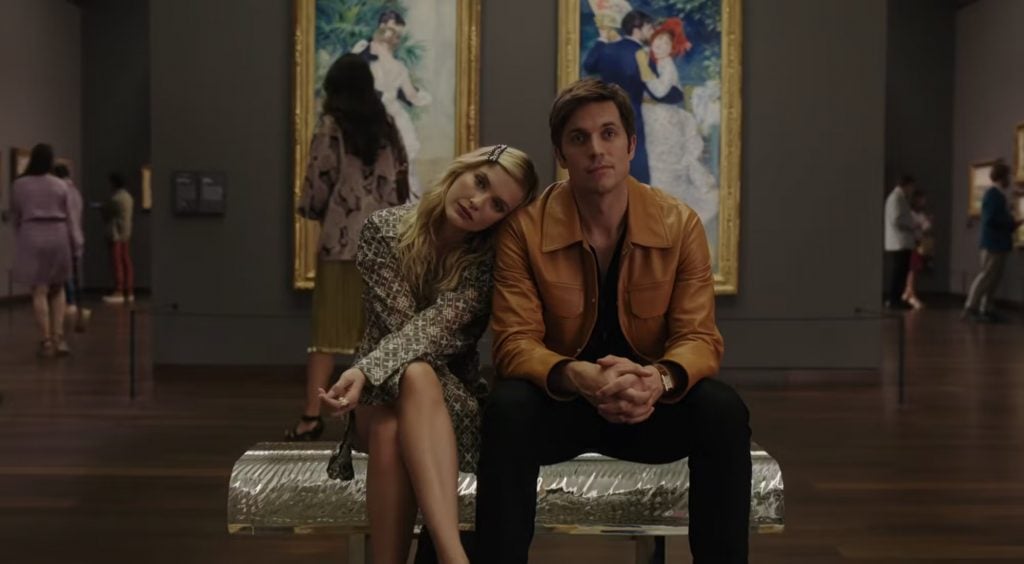Pop Culture
‘Emily in Paris’ Meets Monet at the Artist’s Famed Giverny Garden
Emily learns about Monet's water lilies—and falls into the famed pond.

Emily learns about Monet's water lilies—and falls into the famed pond.

Sarah Cascone

That intrepid young marketing executive Emily Cooper (Lily Collins) is back in Paris, living her best life: fabulous fashion, sexy men, and… falling into the lily pond at Giverny, the home of Claude Monet? The fourth season of the Netflix hit Emily in Paris sees the titular Lily Collins character visit Monet’s garden, where she takes an unintended dip beneath the Impressionist artist’s Japanese bridge.
As one might expect, Emily makes the trip thanks to her friend and romantic rival, Camille deLalisse (Camille Razat), who works at a contemporary art gallery. (The real Perrotin gallery serves as the set for her fictional place of employment.) Camille isn’t at Giverny for work, but to escape heartbreak, after putting a stop to her own wedding ceremony by declaring that the groom, Gabriel (Lucas Bravo), was actually in love with Emily.
After storming off, Camille went missing in action, and stopped returning calls from friends and family. Luckily, she had previously shared her location with Emily, allowing the American to track her down at the pink house where Monet painted his famed water lilies. (It’s about an hour-and-a-half drive outside Paris.)
Today, Giverny is a museum. Emily, of course, manages to walk right in without a ticket. Despite her bumbling French, Emily is able to enlist a friendly tour guide to help her find Camille, who is apparently working as a volunteer. (I love a girl whose idea of running away from her troubles is to flee to an art museum and work in the garden.)

Lily Collins as Emily Cooper visiting Claude Monet’s garden at Giverny in Emily in Paris. Photo by Stephanie Branchu, courtesy of Netflix ©2024.
“I bet she’s cleaning the lily pads,” the helpful guide told Emily. “It’s a tradition Monet himself started… Monet purchased all his water plants from the Latour Marliac nursery, where they had recently created a new variety of colorful waterlilies that were introduced at the 1889 Paris World Fair. Before that, Europeans only had white waterlilies.”
As an art lover who made her first trip overseas as an 11-year-old specifically to visit Giverny, I find this factoid fascinating. But Emily has no time for clunky art historical exposition. Before you know it, she is climbing into a volunteer-only row boat and swinging an oar at Camille, who just wants to be left alone.
Of course, this inevitably ends with the two in the drink—and in hot water with the tour guide.
“I’m gonna make a donation, so we don’t get banned for life,” Camille assured Emily, before explaining why she ran away.
“Giverny is where I fell in love with art,” she said. “Being here, you understand why the Impressionists painted like they did. It’s about… capturing nature. None of it is perfect, but all of it is beautiful.”
(It’s worth noting that the flowers were actually fake, installed by production designer Anne Seibel during the off-season shoot, as reported by Condé Nast Traveler.)
The two make up and agree to return to Paris—but not before buying dry clothes, naturally. I am willing to bet this is the only time we’ll see fashion-conscious Emily and Camille in sweatshirts, even if they are Monet-branded!
It’s a moment that recalls the show’s first season, which catapulted the merch-heavy Immersive Van Gogh into the zeitgeist when Emily, Camille, and Gabriel visited the exhibition. (Monet has since gotten the same animated projection treatment.) There was a similar outing to a balloon museum in season three.

Lily Collins as Emily at the balloon museum in season three, episode seven, “How to Lose a Designer in 10 Days”” of Emily in Paris. Photo by Marie Etchegoyen, courtesy of Netflix ©2022.
The more traditional art world has also had its moments in the series, including a cameo from veteran auctioneer (and Artnet News contributor) Simon de Pury.
And Emily’s fashion clients stage a runway show at Versailles in season two and a retrospective at the Musée des Arts Décoratifs in season three. (Although the real museum is in a wing of the Louvre, the episode was shoe on a set built for the occasion.)

Camille Razat and Lucas Bravo as Camille and Gabriel visiting the Musée d’Orsay and sitting in front of Pierre-Auguste Renoir’s Dance in the Country and Dance in the City in Emily in Paris season three episode nine, “Love Is in the Air.” Photo courtesy of Netflix, ©2022.
But the most notable scene was Gabriel and Camille’s visit to the Musée d’Orsay, where they reminisced about their past, including their first date, which was at the institution. (Amusingly, the museum has actually hosted its own digital Van Gogh show, which critics hated, but broke attendance records.)
Gabriel playfully imitated the Edgar Degas statue Little Dancer Aged Fourteen, and sat with Camille in front of Pierre-Auguste Renoir’s Dance in the Country and Dance in the City. Then, the two got engaged in front of a pair of Monet’s “Rouen Cathedral” paintings—a romantic moment, although ultimately ill-fated.
The first half of the fourth season of Emily in Paris dropped August 15, with the back half due September 12.